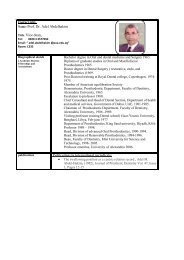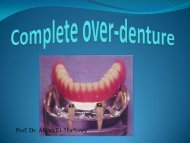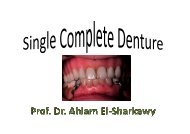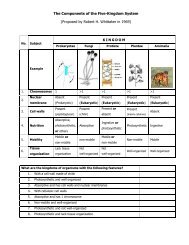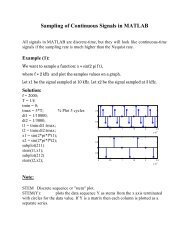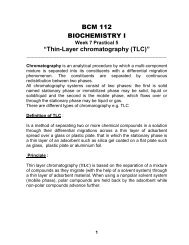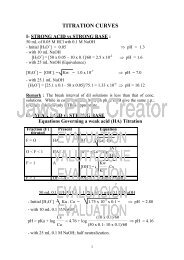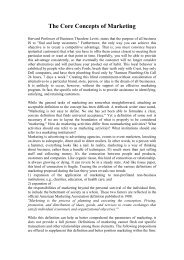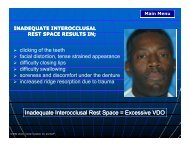CLASS III CAVITY cont.
CLASS III CAVITY cont.
CLASS III CAVITY cont.
You also want an ePaper? Increase the reach of your titles
YUMPU automatically turns print PDFs into web optimized ePapers that Google loves.
Restoration of<br />
primary incisors and<br />
canines
Restoration due to :<br />
o Caries<br />
o Trauma<br />
o Developmental defects<br />
3
<strong>CLASS</strong> <strong>III</strong> <strong>CAVITY</strong><br />
• Carious lesions on the proximal surfaces of anterior<br />
primary teeth .<br />
• If the carious lesion has not involve or weaken the<br />
incisal angle, a small conventional class <strong>III</strong> cavity .<br />
6
<strong>CLASS</strong> <strong>III</strong> <strong>CAVITY</strong> <strong>cont</strong>.<br />
•Mandibular primary incisors with small<br />
proximal carious lesions may not require<br />
conventional restorations.<br />
• Enameloplasty of the affected proximal<br />
surface (usually described as "disking") to open<br />
the proximal <strong>cont</strong>acts and to remove most, if<br />
not all, of the cavitations, followed by topical<br />
treatments with fluoride varnish.
Class <strong>III</strong> adhesive restoration<br />
Conservative restoration for small<br />
interproximal lesions must be kept very small<br />
due to large size of the pulps.<br />
Retention is achieved by using:<br />
a. Retentive locks.<br />
b. Bevel of cavo surface margin.<br />
8
Schematic drawing of carious lesions on the mesial surfaces of maxillary<br />
primary central incisors that do not undermine the mesial angles of the<br />
teeth. The dotted line indicates the proposed labial outline of the class <strong>III</strong><br />
cavitypreparation.<br />
B, Proximal view illustrates that the class <strong>III</strong> preparation is limited to the<br />
cervical two thirds of the primary incisor.<br />
9
MODIFIED <strong>CLASS</strong> <strong>III</strong> <strong>CAVITY</strong><br />
PREPARATION<br />
The modified class <strong>III</strong> preparation uses a<br />
dovetail on the lingual or occasionally on the<br />
labial surfaces of the tooth.<br />
The preparation allows for additional retention<br />
and access necessary to insert the restorative<br />
material properly.<br />
10
Lingual and labial views of a modified class <strong>III</strong> preparation for a maxillary<br />
primary canine. The dovetail improves retention form of the preparation<br />
and allows access for placing the restorative material to ensure<br />
adequate <strong>cont</strong>act with the adjacent tooth.<br />
11
Lingual and labial views of a modified class <strong>III</strong><br />
preparation for a mandibular primary canine.<br />
12
Steps in prep. Of a class <strong>III</strong><br />
Anesthesia and rubber dam application.<br />
Place wooden wedge to minimize gingival<br />
hemorrhage.<br />
Access using No 330 bur or No 2 round bur.<br />
Axial wall 0.5 mm in dentin.<br />
Round bur on low speed to remove deep<br />
decay.<br />
Just break <strong>cont</strong>act and keep incisal one third.<br />
14
Steps in prep. Of a class <strong>III</strong> Cont.<br />
Dove tail or lock on the labial surface.<br />
Place a short bevel 0.5 mm at the cavosurface<br />
margin using fine taper diamond or flame-<br />
shaped composite finishing burs.<br />
Clean and dry the preparation.<br />
Place a plastic or sectional metal matrix.<br />
15
Class V restoration for incisors and<br />
canines<br />
It may be adhesive ( most frequently) or<br />
amalgam.<br />
Most frequently on facial surface of canines.<br />
Using bur No 330 until reaching denin.<br />
Pulpal wall parallel to outer enamel surface.<br />
17
Lateral walls slightly flared.<br />
Mechanical retention achieved by creating<br />
smally undercuts at:<br />
i. Gingivoaxial line angel.<br />
ii. Incisoaxial line angle.<br />
Short bevel for resin-based composite.
Adhesive<br />
materials in<br />
primary molars
Advantages of adhesive restorations in<br />
1. Improved esthetic.<br />
2. Low thermal conductivity.<br />
3. Elimination of mercury.<br />
4. More conservative .<br />
primary molars:<br />
5. Bonding of restorative material tooth<br />
structure.<br />
24
Disadvantages of adhesive restoration<br />
1. Increased operating time.<br />
2. Technique sensitive.<br />
3. Potential marginal leakage and postoperative<br />
sensitivity.<br />
4. Tendency to open or loss <strong>cont</strong>act.<br />
25
General principles for resin based<br />
composite restoration<br />
• Composite resin restoration very negatively<br />
affected by moisture.<br />
• Preparation very conservative.<br />
• No need for mechanical retention<br />
(micromechanical retention) .<br />
• Common sense and knowledge of dental<br />
materials.<br />
27
Rubber dam placement prior to restoration of aproximal lesions with composite resin.
Class I and II prep. For adhesive<br />
restorative material.<br />
• The steps very similar to amalgam except:<br />
1. Absolute moisture <strong>cont</strong>rol.<br />
2. Narrow ismuth (1/4).<br />
3. Prep. restricted to the region of caries (no occlusal<br />
extension and no extension to self cleansing areas).<br />
4. Short bevel is highly desirable.<br />
5. Dentin bonding or glass ionomer lining placed before<br />
matrix band and adhesive material.<br />
29



